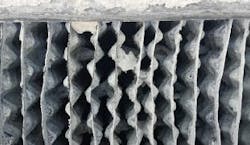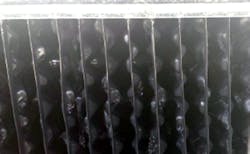Data Centers: Engineering Next-Gen Cooling Systems
By PETE ELLIOT and RICHARD TRIBBLE, Technical Consultants, ChemTreat
As AI workloads intensify and rack densities rise, cooling has become a defining constraint of modern data center infrastructure.
Direct-to-chip (D2C) liquid cooling and other closed-loop systems are quickly becoming essential in hyperscale environments. Yet, while much of the attention has focused on mechanical configuration, pump redundancy, and fluid routing, the chemical treatment of these systems plays an equally important role in ensuring long-term efficiency, uptime, and sustainability.
The new wave of data centers being built today will operate under higher thermal loads, higher density equipment deployment, and growing pressure to manage power and water more effectively. That gives specifying engineers a chance to shape performance from Day One. By integrating advanced water treatment strategies, predictive monitoring, and system readiness protocols into early-stage design, engineers can dramatically improve operational resilience and reduce long-term total cost of ownership.
Designing for Cycles of Concentration and Water Chemistry Risk
For years, cycles of concentration (COC) have been a core consideration in evaporative cooling tower systems. Increasing COC reduces water discharge and chemical use, but it also raises the risk of mineral scaling, particularly from calcium carbonate and silica. In traditional systems, the balance has always been between maximizing conservation and minimizing the potential for scale-induced heat transfer losses and reduced service life from under-deposit corrosion.
That balance becomes even more delicate in high-density environments, where thermal efficiency must be maintained across more compact heat exchangers and higher delta-T ranges. Design-stage decisions such as exchanger materials, control valve configurations, and system flow rates must account for how local source water chemistry and COC targets will affect long-term operability.
In D2C systems, the operating concerns shift. These close-loop systems have little or no evaporation, meaning COC is not a driving factor. Instead, the focus is on controlling corrosion, preventing microbial fouling, and ensuring fluid stability over time. These systems are particularly vulnerable to microbiological growth and material incompatibilities if the water treatment strategy is not aligned with the system’s intended use and flow characteristics.
At startup, improperly cleaned or passivated systems can introduce particulate loads and corrosion initiators that compromise long-term reliability. System design should allow for proper flushing and cleaning access points from the beginning, not after performance issues arise. Pretreatment of makeup waters used in D2C systems often includes reverse osmosis or demineralizers. This creates a more corrosive pure water, which needs to be treated accordingly with chemical inhibitors to protect wetted materials of construction.
Proper flushing of these systems may involve the system’s volume being “turned over,” or replaced 3–6 times, to achieve clear water with characteristics approaching that of the flush water moving through the system. Therefore, provisions must be made for the disposal of this flush water, which may contain various contaminants associated with the pre-operational cleaning process.
Fouling, Scaling, and the Thermal Performance Penalty
The most common failure modes we see in both evaporative and closed-loop systems are thermal losses caused by surface fouling, whether from scale, biofilm, or suspended solids. Even a thin layer of mineral scale or organic growth can reduce heat transfer efficiency by more than 10 percent. Furthermore, biofilms are approximately four times more insulative than standard mineral-based scales, such as calcium carbonate (CaCO3).
Over time, this forces chillers or pumps to work harder to maintain temperature setpoints, increasing energy consumption and shortening asset life. This phenomenon is observed principally in the chiller’s compressor, which acts as the largest electrical load for the chiller as a whole. Any scale or biofilm accumulation in the chiller’s condenser water tubes will increase condenser shell head pressure, forcing the compressor to discharge against a higher back pressure, requiring a higher electrical power (amperage) draw, and increasing associated electrical utility costs.
In early D2C deployments, we have observed that even small inconsistencies in system fill procedures or missed pre-operational treatments have resulted in fouled exchangers that required full system shutdowns for remediation. These are avoidable failures if engineers design with both water quality control and monitoring infrastructure in mind.
As has been observed and documented, the duty life of cooling equipment is dictated by its condition when it was commissioned. A well-prepared system that is treated, stabilized, and monitored before load is applied will consistently outperform one that is retroactively adjusted after thermal instability sets in. This is critical in data centers running AI or HPC workloads, where temperature spikes can result in CPU throttling, hardware strain, or even safety shutdowns. In these cases, the chemical readiness of the system can be as important as the mechanical design.
Rapid Monitoring and Design Integration
While many facility operators now rely on monitoring platforms to track system health, the effectiveness of these tools depends on thoughtful integration during the design phase. Flow meters, sampling ports, corrosion coupon racks, and automated controllers need to be part of the mechanical and controls layout, not field-added after commissioning. Designing around data allows operators to track fluid stability, detect corrosion trends, sense potential system leaks, and fine-tune chemical feed rates well before issues arise.
In recent field deployments, the use of monitoring-enabled treatment programs has allowed operators to identify system-side corrosion, track scaling risk indices in real time, and automate chemical dosing based on load and temperature fluctuations. This visibility has reduced water consumption, improved thermal stability, and decreased technician response times. Engineers who anticipate the need for these technologies in the design phase enable a more stable and responsive operating environment for years to come.
Meeting Performance and Sustainability Metrics
As environmental scrutiny increases, engineers are also being asked to design cooling systems that contribute to corporate ESG targets. While data center operators remain focused on uptime and reliability, the ability to improve water usage effectiveness (WUE), power usage effectiveness (PUE), and long-term chemical sustainability are now part of the value equation.
Optimized treatment strategies can reduce blowdown, minimize chemical waste, optimize the appropriate risk threshold, and extend asset life. At one facility, improved system preparation and fluid monitoring recently led to a seven percent gain in thermal efficiency and an 18 percent reduction in annual water discharge. These are not just operational improvements, they are measurable contributions toward resource conservation and cost control. It cannot be overstated that these environmental gains do not place the operating system assets at risk.
Getting It Right the First Time
The new generation of data centers is being built with a 20-to-30-year design life, yet many system-level failures occur within the first five years due to preventable issues like corrosion, microbial contamination, or thermal performance degradation. Specifying engineers have an opportunity and a responsibility to ensure that the chemical and monitoring infrastructure behind the cooling system is just as robust as the piping, valves, and exchangers themselves.
This involves asking questions in the design phase that are typically absent from traditional workflows: Will this loop be cleaned and passivated prior to commissioning? Will these activities be supported by formal written procedures and reviewed prior to implementation? Where will water quality be sampled? Can the operators track corrosion trends, or are they flying blind? These questions help define whether the system will meet today’s demands and long-term performance.
As AI continues to reshape the future of computing, it is time to rethink how we engineer the thermal infrastructure behind it. Reliability does not just come from design—it comes from readiness gained through experience and collaboration with knowledgeable water treatment specialists.
About the Authors
Pete Elliott, Senior Technical Staff Consultant, ChemTreat Pete Elliott serves on the Applied Technology team at ChemTreat, providing energy and water usage sustainability solutions in all areas of cooling water innovation and integration.
Richard Tribble, Technical Service Consultant, ChemTreat Richard Tribble is a Cooling Product Champion and Technical Consultant for ChemTreat, a provider of water treatment solutions for data center facilities in North and South America.


